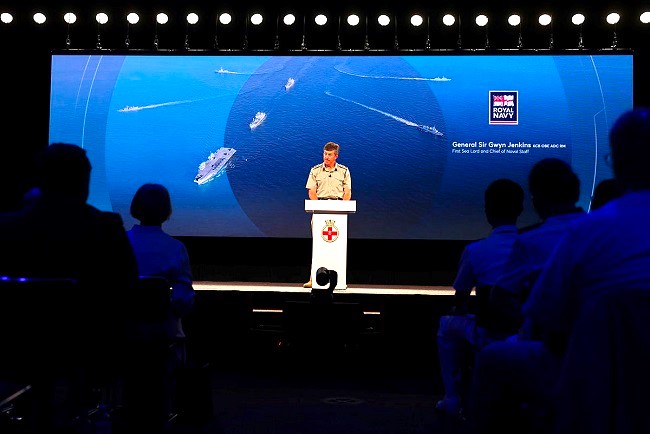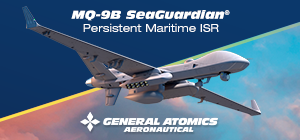
Coming from what is arguably the most innovative branch of the Armed Forces at the moment, the Royal Marines, the new First Sea Lord, General Sir Gwyn Jenkins (the very first Royal Marine ever to become the head of the Royal Navy), has set an extremely ambitious agenda of modernisation for his 4-year tenure, publicly announcing a series of targets he wants to be held accountable against.
The overriding principle that guided his speech at DSEI has been unambiguously worded: the Navy is to be “uncrewed wherever possible; crewed only where necessary”.
The Royal Navy has been working towards the so-called “hybrid fleet” for years now, with progress most evident in mine countermeasures through the Mine Hunting Capability (MHC, see Future Warfare Issue N°1/2024) and hydrographic and survey work through Project HECLA, but the aim now is going much further.
On the way towards creating the first true “hybrid air wing” (at least in Europe) for the aircraft carriers, the First Sea Lord said “We intend to launch the first jet-powered collaborative platform drone as a concept demonstrator off a QUEEN ELIZABETH-class aircraft carrier as soon as next year”. It’s not clear at the moment which jet has been identified for this key trial: so far, the only jet-powered drone to take off from a QE-class deck was the Qinetiq BANSHEE 80+, a small aircraft employed mostly for threat simulation, although project VAMPIRE looked at spiral developing it for EW and ISR roles as well.
It was instead decided a few months ago to move on past BANSHEE as it was assessed that the times were mature for more complex platforms.
In August, a placard by the Navy presentation team was seen showing the short term aim of standing up a first Squadron equipped with drones, mostly One Way Strike effectors (OWEs), growing to 3 Squadrons of Collaborative Platforms plus OWEs by around 2030. The RAF has recently published a first call to industry for the next round of ACPs purchase, calling for a stealthy strike platform (one-way) which, in accordance with the Strategic Defence Review (SDR), should indeed be carrier-capable.
In an interview from aboard HMS PRINCE OF WALES in Tokyo, the First Sea Lord reiterated publicly that “by the time the Carrier Strike Group returns to the Indo-Pacific for its next episodic deployment” (which in theory means, again, in circa 4 years time), the F-35Bs on deck would be accompanied by their Autonomous Collaborative Platform, with another platform also on deck providing Airborne Early Warning, replacing CROWSNEST (MERLIN HM-2 helicopter) in the role, with yet another drone used for “intra-fleet” logistic lift.
HMS PRINCE OF WALES has just demonstrated the use of Malloy TRV-150 quadcopters for small scale ship-to-ship deliveries, with the future ambition to scale up possibly through the 3-ton PROTEUS uncrewed helicopter by Leonardo UK, soon to make its first flight. The Royal Navy has just now officialized a full release to service for both the Malloy quadcopter and the Schiebel-Thales S-100 PEREGRINE RUAV, which has operated for months already on HMS LANCASTER in the Persian Gulf and Indian Ocean, contributing to important drug busts. With the wider use of PEREGRINE now possible, the addition of weapons (LMM missiles) is being looked at, as well as the possibility to scale up onto the larger S-300 airframe.
In terms of AEW, the most obvious solution at present would be the “navalization” of the MQ-9B PROTECTOR with the STOL wing kit in development. General Atomics and Saab are working together on a podded radar system for AEW (and GA-ASI is also working with Ultra for an ASW solution). While not yet a firm program of record, this is understood to be the intent, with the Strategic Defence Review having explicitly named PROTECTOR’s potential over the sea.
The 1SL added that “we will have our first BASTION sensors in the water next year”, referring to ATLANTIC BASTION (project CABOT), one of the highest priorities emerged from the SDR: the intent is to create an ASW barrier underpinning an “underwater defence posture from the Mid-Atlantic Ridge to the Norwegian Sea”.
ATLANTIC BASTION aims to “a blend of crewed and uncrewed host platforms will be networked together, but capable of independent operations, creating a system of systems that will enable us to find, track and if required act against our opponents, adding both mass and lethality”. It is (eventually) supposed to include an optionally manned or fully autonomous large USV indicated as “Type 92 SLOOP” and an uncrewed large submersible, the “Type 93 CHARIOT”. The current experimental ship XV PATRICK BLACKETT (expected to soon sail at Autonomy Level 4) and the XLUUV XV EXCALIBUR should provide a pathway there, although the first sensor to be deployed is likely to be the Helsing SG-1 FATHOM uncrewed underwater glider with ASW sensors and LURA Artificial Intelligence core. Production of these is due to start in a new factory in Plymouth.
The 1SL depicted a future in which a Type 26 can go to sea working as a mini task-group, flanked by 2 uncrewed escorts. On the way there, he wants “the first of our uncrewed escort ships sailing alongside our RN warships within the next 2 years. We will then begin scaling across the Navy”. Depending on the shape of said ship, that is a very ambitious ask, unless the already mentioned XV PATRICK BLACKETT counts.
Under Project LILY, the Royal Navy expects to put to sea early next year a survey and hydrographic USV capable of “global operations” but that won’t be an “escort”.
“We are also working to take this approach into our concepts for both the Multi Role Strike Ship (replacement amphibious vessels to be built over the coming years) as part of our future littoral ships and for the Type 83 as our future Air Defence Destroyer, which will fundamentally change and improve what can be produced. I want both to be founded on a family of vessels, with crewed capabilities at their heart, but more modular, resilient, dispersed and powerful”.
There are notional plans for a “Type 91” large uncrewed ship adding VLS depth to the Type 83.
In his interview in Japan, the 1SL said the uncrewed escort ship would be around 90 m long. So far, the proposal that goes closer to that (indeed closer to 100) is the BAE Systems Deployed Sensor and Effector based on the TRITON experimental trimaran from the early 2000s, showcased in (undetailed) model form at DSEI. Getting a USV of this size and complexity into the water within 4 years appears to be the most challenging part of the whole plan, given that most of the rest builds on work already ongoing.
The 1SL insists that getting it done is possible, and that the Navy’s job is to demonstrate it.








.png)
